If you’re a woman, the more professionally successful you are, the less you make relative to your male colleagues.

That’s true in any industry or occupation: in the health sector and management; in education, mining, finance and retail — the latter being both the most gender-balanced, compensation-wise, as well as the lowest-paying industry in the Canadian Centre for Policy Alternatives study, published Monday.
The study used data from the 2013 Canadian Income Survey to calculate the difference in Ontario men’s and women’s average annual incomes depending what income group they’re in, what education they have and what field they work in.
The only rung of the earnings ladder where women’s pay tops men’s is the bottom: The poorest 10 per cent of women make about $190 more a year, on average, than the poorest 10 per cent of men.
After that, men make more and the gap gets larger.
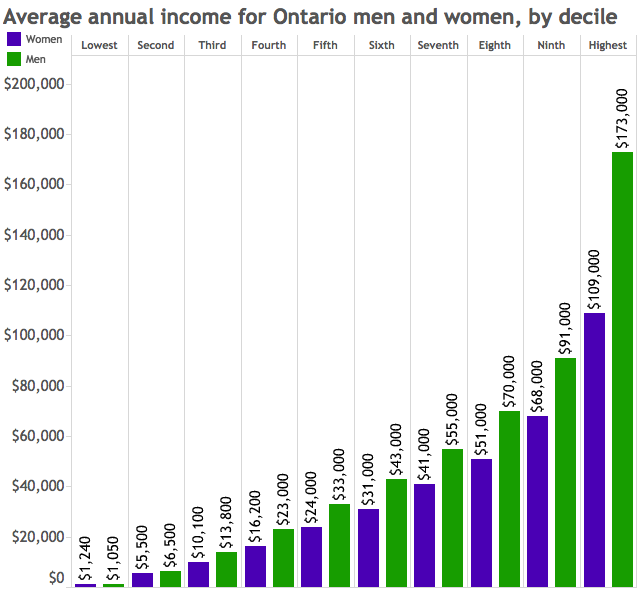
Men in the second grouping earn 18 per cent more than women in the same group; in the fourth grouping, 42 per cent more.
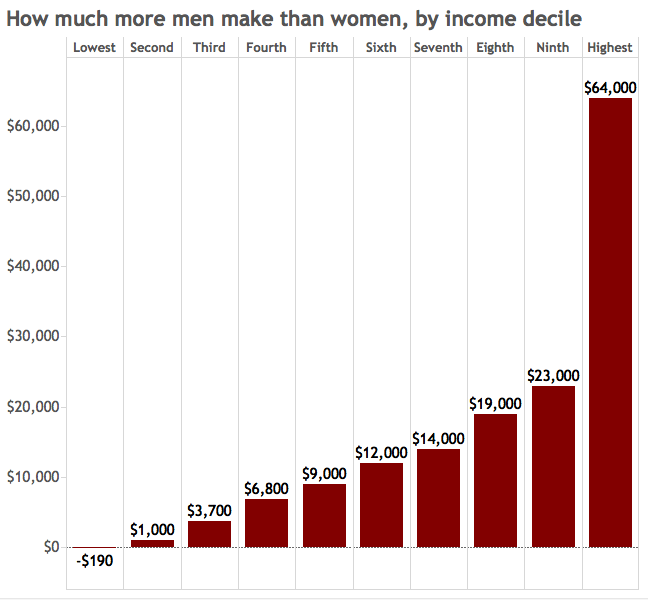
The highest-earning men earn almost 60 per cent more than the highest-earning women.
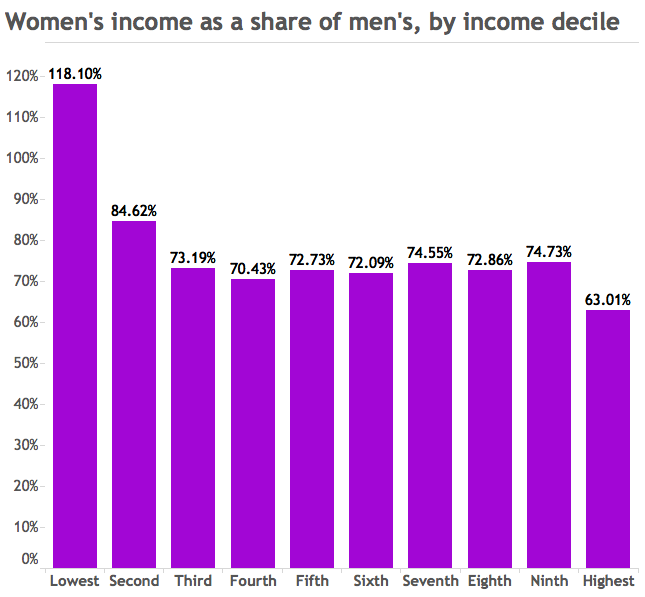
These gaps persist in prestigious occupations: Women who work in health and government make less than two-thirds what their male counterparts make.
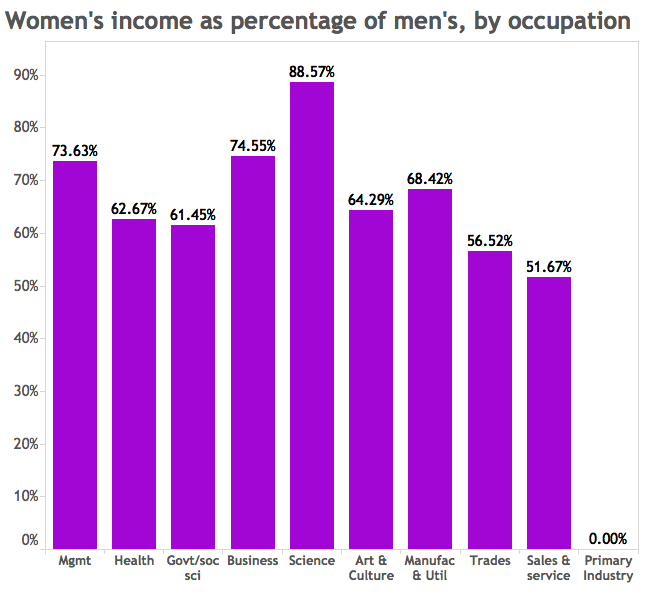
The disparity persists no matter how much education you have.
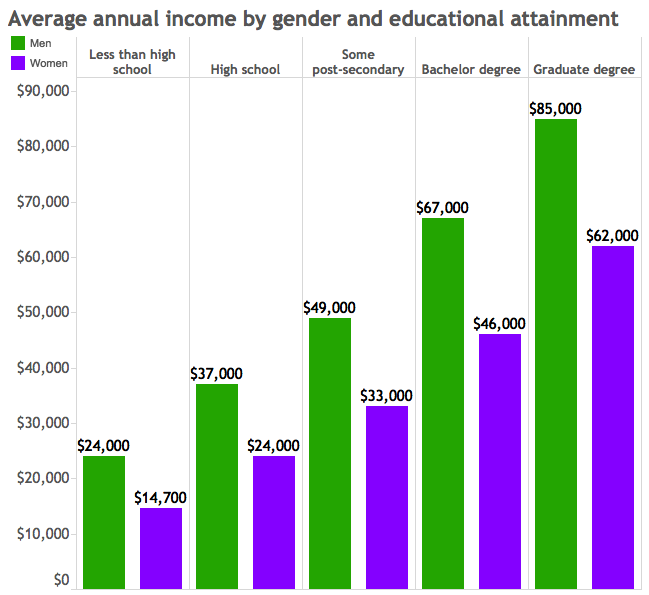
In this case, however, the additional education pays off: Even though women earn less than men regardless of their credentials, that gap shrinks the more educated they are.

Some of the factors behind this pay gap are systemic: If women shoulder the child-care burden, as they disproportionately do, they’re more likely to work fewer hours or take time off to care for children, or take lower-paying jobs that give them flexibility to make daycare pickup.
These factors reinforce each other: If a male partner’s making more and child care’s out of reach, his female partner is more likely to be the one to put her career on hold to take care of kids at home.
But even if you ignore all of that and compare compensation for men and women doing the exact same work for the exact same number of hours, there’s still at least a 14 per cent gap overall, said study author Mary Cornish.
“There are still significant gender gaps between the earnings, overall, of women doctors and male doctors,” she said.
“You could also still have lawyers doing the same things and being paid differently.

Women’s work is valued less, unconsciously or not, even when they’re doing the same work.
“That’s a long history of the association of things that are female as being undervalued in society,” Cornish said.
“It moved into paid work — it wasn’t paid highly enough.”
This is reflected in research elsewhere: When women enter male-dominated fields, the New York Times reported last month, the pay in those fields drops.
And it isn’t because women are less competitive or more family-oriented: A long-term study of Harvard Business School MBA graduates found men and women had similar goals both at the outset of their careers and decades later.
But despite equivalent qualifications and similar priorities, men were still more likely to have managerial positions, oversee other employees or have profit-and-loss responsibility.
Wage transparency could help address income issues, Cornish says: Just letting people know what their co-workers are making can shine a light on inequities that might otherwise go unnoticed.
“There is currently no law against an employer saying that it’s secret,” she said.
“If you ask you should be told.”
(That’s also an argument for the pay grades that come with unionization, Cornish notes.)
But the government has an enforcement role as well, she argues:
“There’s not a lot of enforcement,” she said.
“The government should be monitoring employers on whether or not they’re systematically paying their female employees less.
It’s more than an issue of fairness: When women don’t feel valued in their workplace, they leave.
The Law Society of Upper Canada tracked lawyers called to the bar in 1996 who did criminal law in private practice. By 2014, 60 per cent of the women in the group had left the field, compared with 47 per cent of men.
It goes beyond financial or familial concerns, a Criminal Lawyers Association study found: The majority of female private practice criminal lawyers said they were considering leaving, many citing poor treatment from judges, clerks, clients and fellow lawyers treated them differently because they were women.
“Many reported feeling that criminal law was a poor environment for women to work in, with others discussing feelings of being ‘dumped on’ by media, Crown lawyers, court clerks, judges, and even their clients,” the survey reads.
“The private practice of criminal law was seen as very much still an ‘old boy’s club,’ leaving many women feeling poorly treated simply because they are women and reconsidering why they ought to stay in the practice.”




Comments